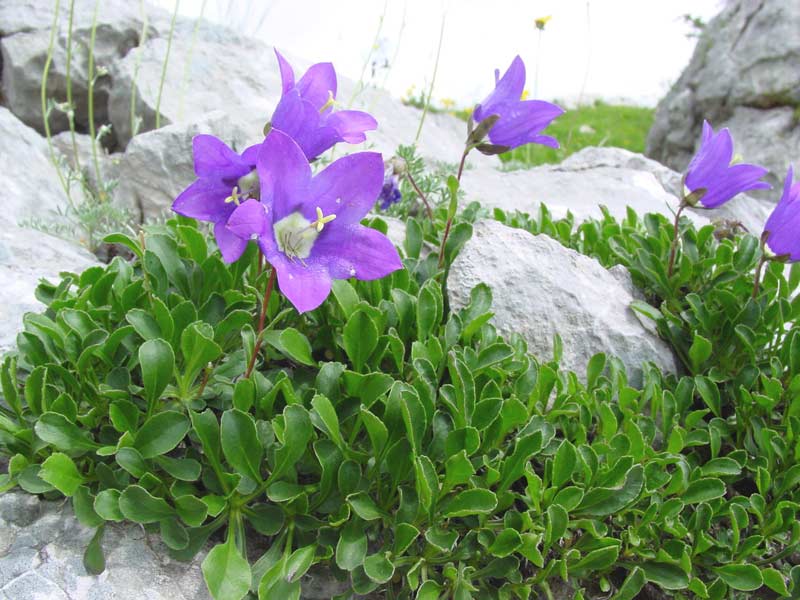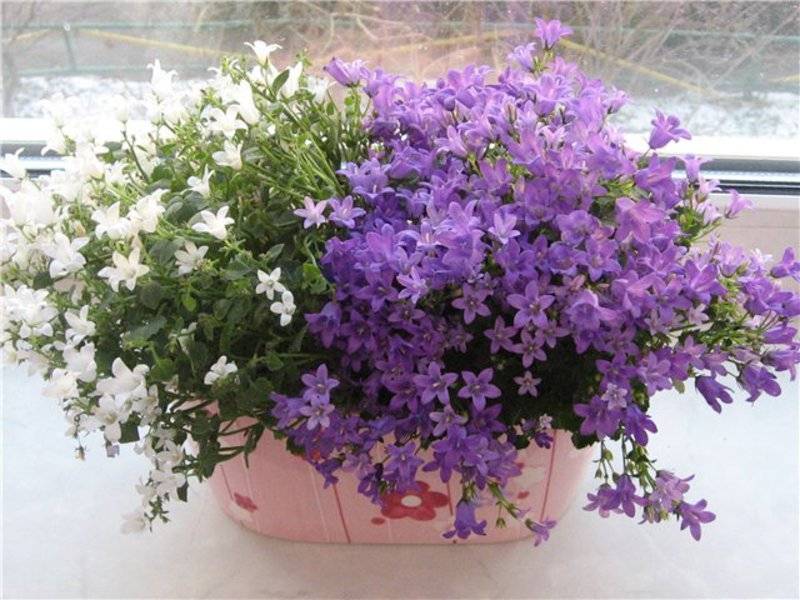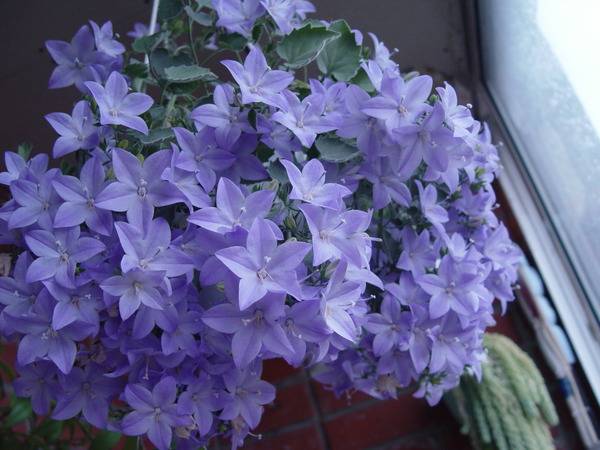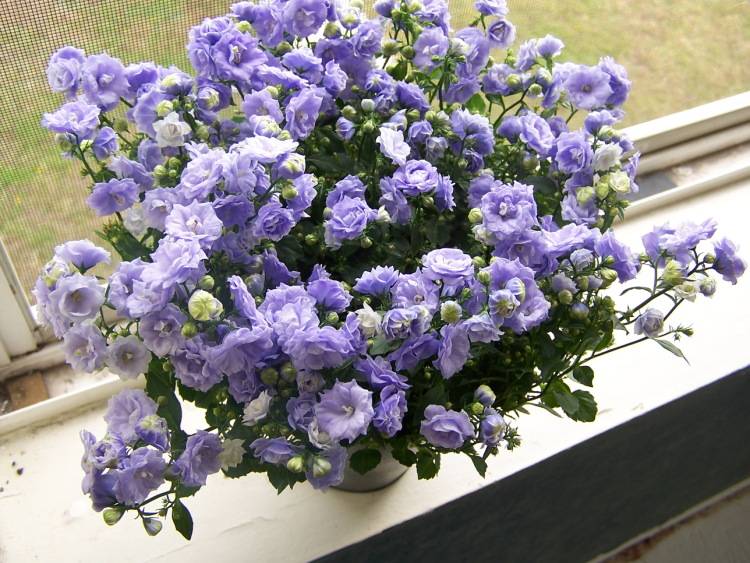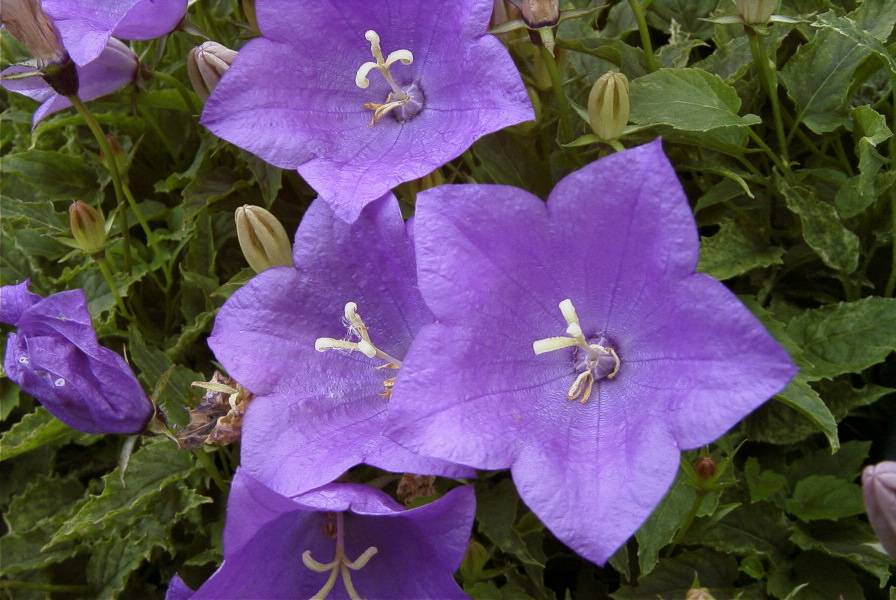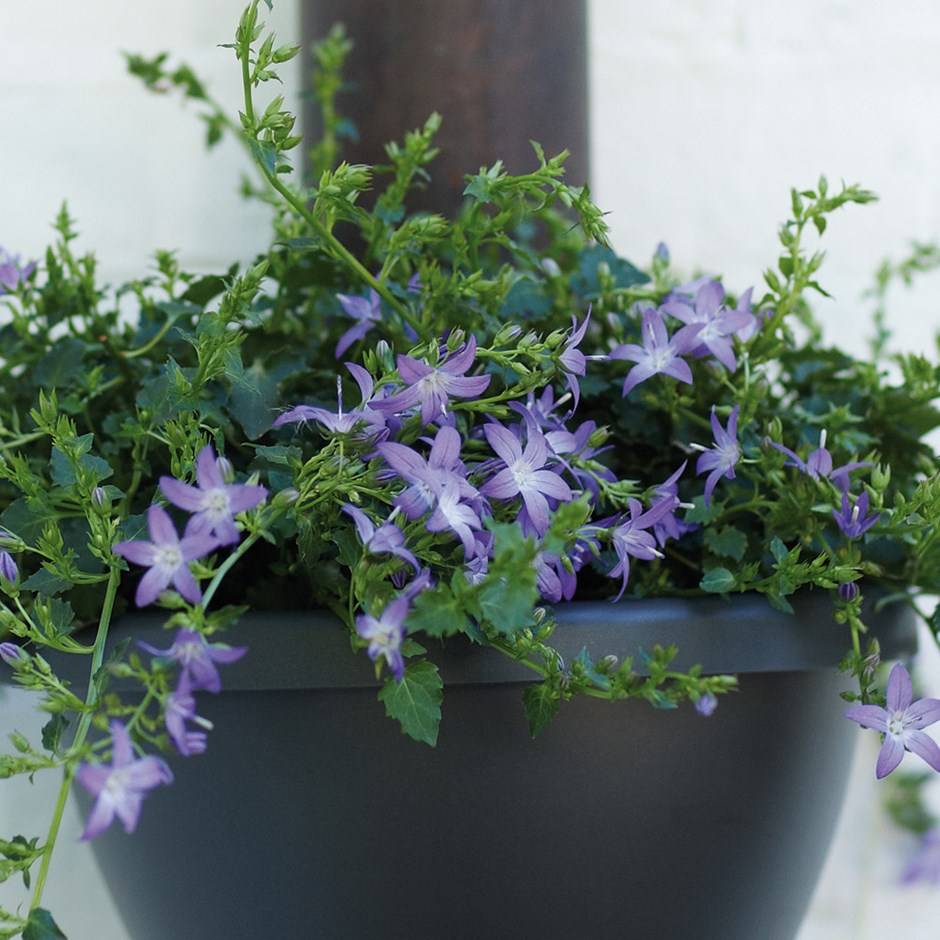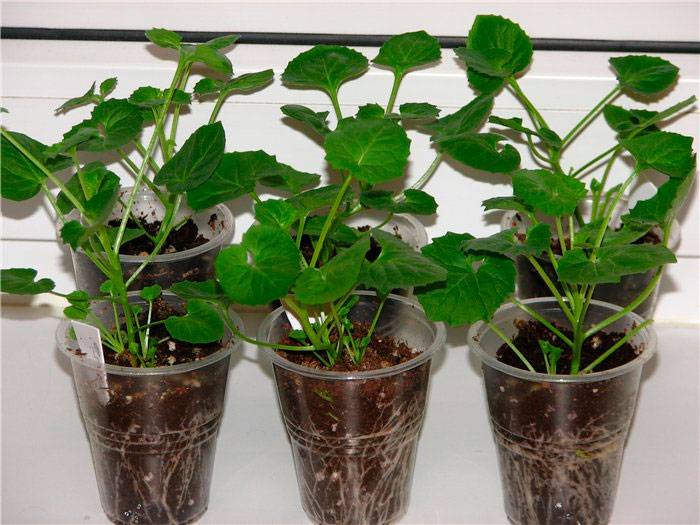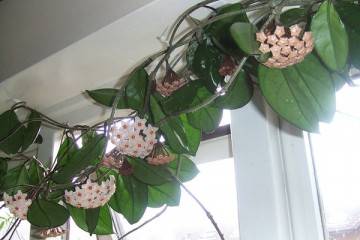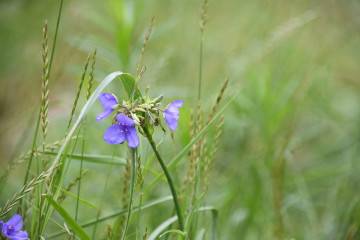Campanula - home care
Content:
Campanula flower has been popular with Russian flower growers for several decades. Its rating went up and down, and now the time has come when this beautiful flower again takes pride of place on the windowsills of lovers of home flowers. All qualities are appreciated in a plant at once - and incredible bright and lush flowering, and unpretentiousness, and even the signs and superstitions that surround the campanula.
Campanula (bride and groom) - what kind of flower is it, what family it belongs to
Campanella is a flower popularly called the Bride and Groom. It belongs to the Bellflower family, which includes more than 400 species. They are widespread in many countries of the world, excluding the hot, humid tropics. The name of the species comes from the word campana, which translates as a bell. Campanula is often called a bell. There are wild, garden and home varieties. It often happens that indoor varieties tolerate summer well in outdoor conditions.
Brief description, history of origin or selection
There is a legend that it was the church bell that got its name due to the similarity with these amazing flowers, and not vice versa. After all, the first bell was cast in the Italian province of Campania. There, Bishop Paulin noticed these amazing flowers and decided to cast similar ones, but of copper.
Since campanella is a flower that is gaining popularity in the modern world, the work of breeders on the development of new hybrid varieties is gaining momentum. A huge number of varieties have already been created, differing in color, shape and structure of the flower. But they are all hybrids of the Campanula isifolia.
A brief botanical description of room campanula is as follows:
- thin creeping or hanging stems with shoots about 25 cm long;
- leaves are light green, heart-shaped, rounded, located on long petioles, medium-sized, about 3 cm in length;
- flowers are collected in inflorescences, each of which contains several flowers, up to 5 cm in diameter;
- the colors of the bell flowers are different: initially there were only 2 of them - white and purple, now there are much more. There are pink, blue, light lilac and other colors. There are even two-color options;
- flowering occurs in the second half of June and lasts until the end of August;
- fruit-box.
Varieties of indoor plants with names, what they look like
Breeders do not stop working on improving the flower and breeding new hybrids.Campanula is an indoor flower, all varieties of which are rapidly gaining popularity. However, there are those among them that are loved by flower growers the most.
Campanula isifolia
This type of campanula includes the beloved bride and groom. The diameter of the flowers is up to 4 cm, the leaves are green with slight pubescence. This is an ampelous type of campanula that prefers growing in hanging pots and pots.
Alba and Maya bloom from the second half of July. The plant is quite capricious, but it is possible to grow it and achieve flowering. The flowering period is quite short, but it can be extended by carrying out all the necessary procedures. In particular, it is important to remove faded flowers in time.
Campanula Blauranca
The stems of this variety are not too long, reaching about 20 cm. The flowers are large, up to 5 cm in diameter, light blue in color.
Terry campanula
Terry Campanunala is a hybrid of an equal-leaved one. Another name is curly. Description of the terry campanula:
- the maximum flower height is only 15 cm;
- thin stems grow very luxuriantly;
- leaves are small, located on the stems very densely, alternately. Leaf shape - triangular;
- double flowers, about 2 cm in diameter. The color is varied, from white to deep purple.
Main varieties: Blue and White Miracle, Blue and White Bali. Often used in the design of alpine slides. In indoor conditions, it grows not too willingly, therefore, for the summer it is recommended to take it out into the garden, on the balcony, on an open veranda.
Campanula Carpathian, or Carpathian bell
Campanula Carpathica is another popular home-grown species. This type of campanula can be grown as a perennial garden form, since it has been converted to indoor from natural conditions. There it grows successfully in shady, rocky terrain.
Description of the domestic variety:
- growth form - bush up to 30 cm high;
- leaves are rich green, ovoid, collected in a basal rosette;
- flowers of lilac-blue color, up to 5 cm in diameter.
Flowering in this species is long - from early June to late August.
Campanula Pozharsky (Poscharskyana)
Campanula Pocharskiana is different:
- leaves of the correct rounded shape;
- long, creeping shoots and dense stems;
- small, up to 2.5 cm in diameter, bright purple flowers
How to care for campanula at home
Care for the campanula bell at home is not too difficult, but it is also not easy. In order for the plant to grow, develop, and most importantly, to blossom and bloom as long as possible, it needs to create comfortable conditions. In the summer, you can transfer the flower to the garden and even transplant it into open ground.
Illumination and temperature conditions
The house bell is very fond of well-lit rooms, most varieties do not tolerate shade. And to such an extent that it can not only fail to bloom, but also completely stop in development and even die.
But the light should not be direct, the delicate leaves and flowers of the plant will instantly receive sunburn. Windows located on the east or west side are ideal. The north side is excluded, and the south windows require good shading in hot sunny weather.
The correct temperature regime is one of the main factors for the success of campanula care.In spring and summer, you need to maintain a temperature of about +25 ° С, in winter the flower is allowed to rest at a temperature of +15 ° С.
Watering rules and humidity
The flower is remarkable for its ability to withstand prolonged drought. In the summer, this period can last up to 2 weeks. At the same time, the plant continues to retain its decorative properties. However, do not experiment like this with the campanula located on the south side.
In the heat, regular watering and spraying is required. The spraying procedure should be carried out only in hot, sunny weather. At other times, the house bell does not need it.
Top dressing and soil quality
Top dressing is carried out from mid-March to the end of September - during the active growing season of the plant and during flowering. It is carried out 2-3 times a month with complex fertilizers for indoor flowering plants. In this case, the doses of the substance should be minimal. Better to dilute it with water. In winter, you do not need to feed the flower.
The soil must be loose, moisture and air permeable. An excellent option is a mixture of peat and leafy earth in equal proportions. Ready-made universal primer sold in stores is also suitable. Most importantly, it should be loose.
Flower container size
Since the root system of the campanula develops very quickly, the flowerpot will need a fairly spacious one. The material from which it will be made is not important. The bride and groom will feel great in both clay and plastic pots.
Pruning and replanting
Pruning is done at will at the beginning of the dormant period (October-December). The stems are shortened by 10 cm with sharp disinfected scissors. It is quite possible that after this procedure, the campanula will re-flowering.
The second and obligatory pruning takes place at the beginning of March. All dried branches are removed, and the rest are shortened so that no more than 5 cm remains. This is necessary in order to awaken the buds hidden at the very base of the shoots. They will produce many young, beautiful stems.
Features of flowering plants
During the flowering period, Campanula is especially beautiful. It is for its ability to bloom magnificently and brightly that flower growers love it.
A period of activity and rest
Depending on the variety, the home bell will bloom at different times. But most often the flowering period continues throughout the summer months. At this time, one should not forget about regular watering, feeding and removing wilted flowers.
Types and shape of flowers
The shape of the flowers of all varieties of campanula, without exception, is bell-shaped. No wonder the word campana is translated as a bell. Through the efforts of the breeder, various forms of flowers have appeared:
- simple;
- semi-double;
- terry.
Each of them is beautiful in its own way and will decorate any interior.
Flower reproduction methods
Propagating a bride and groom is not difficult. For this, all the main methods are used.
By cuttings
Propagation by cuttings is quick and painless for both the daughter and the mother plant. The survival rate of the bushes is good, so new flowers grow very quickly.
Grafting takes place according to the following rules:
- A shoot growing at the bottom of the plant is selected and cut off, on which there are at least 2 leaves.
- The lower part of the cutting is disinfected - it is placed in a vessel with a weak solution of potassium permanganate for 30 minutes.
- The cuttings are placed in vessels with clean water, where they are kept until the roots appear.
- Young plants go 3-5 cm into the ground so that they are in a standing position. You can make mini greenhouses.
After new leaves have appeared on the handle, they can be transplanted to a permanent place of residence.
Reproduction by young shoots
Campanula can be propagated in this way only in the spring, when new, young shoots are formed. Several such branches are separated from the main bush and they are planted in the soil usual for this plant in order to root.
It is better to germinate future plants in a cool room. After 2-3 weeks, roots will appear, after which the flowers are transferred to a permanent place of residence, warm and light.
By dividing the bush
This option is ideal for mature plants that are overgrown. The bush is divided into two parts, the roots at the place of the cuts are disinfected with a special solution or crushed charcoal.
Each part is transplanted into new pots, watered well and placed in slightly shaded areas. There they spend several days to adapt, after which they are exhibited in the place where they will grow constantly.
This procedure is ideal for house bells that have been growing in the house for many years. With its help, they will rejuvenate, the growth of new, good shoots will accelerate, and the grower will immediately receive 2 new, refreshed plants.
Growing from seeds
Campanula can also propagate by seeds. This method is very popular with indoor plant lovers. It happens that there is nowhere to take cuttings or shoots, but I really want to grow a beautiful flower. The seeds are sold in almost all flower shops and are inexpensive.
The sowing procedure is carried out as follows:
- Small seeds are evenly distributed in a shallow container with soil mixture and lightly sprinkled with a layer of soil.
- Using a spray bottle, the substrate is gently moistened.
- Then it remains only to wait for the emergence of seedlings, periodically spraying the soil.
The picking of young plants is done when the first three leaves appear in them. As soon as the stems grow up, they are planted in a permanent place.
The optimal time for sowing is early spring. The seed germination rate is very high.
Growing problems, diseases and pests
Due to improper care, campanula can suffer from fungal diseases, rot, yellowing and leaf fall. It happens that she is attacked by a scale insect and a spider mite.
How to deal with them
The answer to the question of why this is happening and how to deal with it is quite simple. The best fight is prevention. A plant for which all conditions of care are provided has a fairly high immunity. Therefore, when the first signs of illness appear, it is worth analyzing the situation, finding the problem and solving it. In the case of pests, treatment with special preparations and the removal of damaged parts of the plant will be required.
Indoor campanula is an amazingly beautiful plant that will adorn any home. How beautiful the flower is during the flowering period, which can last all 3 summer months. The plant will suit both lovers of traditional home flowers (campanula white and purple) and those who want something unusual.
A variety of varieties allows you to satisfy any request. Do not omit the fact that, according to the signs, the flower brings family happiness and peace to the house.
